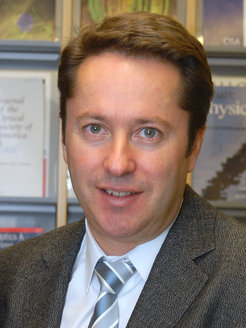Professor Ignacio Cirac receives 2013 Wolf-Prize in Physics
He has been awarded together with Prof. Peter Zoller for their research in the area of quantum information, quantum optics and the physics of quantum gases.

The Wolf Foundation in Israel has awarded the 2013 Wolf Prize in Physics to Professor Ignacio Cirac, Director at the Max-Planck-Institute of Quantum Optics (Garching, near Munich), and Professor Peter Zoller (University of Innsbruck, Austria). The scientists receive this award “for groundbreaking theoretical contributions to quantum information processing, quantum optics, and the physics of quantum gases.” The Wolf Foundation was established in 1976 by Dr. Ricardo Wolf and his wife Francisca. The Foundation has a status of a private not-for-profit organization. Since 1978, prizes have been awarded annually in five or six science fields. The Wolf prize is considered to be the most renowned science award after the Nobel-prize. To date, a total of 253 scientists and artists from 23 countries have been honoured.
Professor Ignacio Cirac was born in the City of Manresa in 1965. He studied theoretical physics at the Universidad Complutense de Madrid where he received his PhD in 1991. He began his career in physics as a “Professor Titular” at the Universidad de Castilla-La Mancha where he stayed till 1996. In 1996 he became Professor at the department of Theoretical Physics at Leopold Franzens University Innsbruck. Here he began his strong scientific collaboration with Professor Peter Zoller. Since 2001 he is Director at the Max Planck Institute of Quantum Optics and head of the Theory Division.
Standard quantum computation is based on a system of quantum particles such as atoms or ions that serve to store and encode information. Key elements in such a quantum computer are quantum gates that couple two qubits at a time. In 1995 the theoretical physicists Cirac and Zoller were the first ones to propose a detailed concept for the realization of two-qubit-gates based on the use of ultracold, electromagnetically trapped ions. On the way to the realization of a universal quantum computer devices using ultracold stored ions are the most advanced up to now. Apart from that, Cirac and Zoller proposed to use ultracold atoms in optical lattices to simulate quantum many-body models. There are several groups around the world carrying out the proposed experiments.
The theoretical tools developed to describe many-body quantum systems may also lead to a better understanding of macroscopic phenomena such as superconductivity. Furthermore, Prof. Cirac and his collaborators created new theoretical tools to characterize and quantify entanglement, and participates in the creation of a new theory of information based on quantum mechanics.
Professor Ignacio Cirac has by now become one of the most renowned scientists in the field of quantum information and quantum computation. E.g., in 2005 he was awarded the “Quantum Electronics Prize” of the European Science Foundation. In May 2006 he was the youngest ever winner of the renowned Royal Spanish Prince of Asturias Prize, and in the same year he received the International Quantum Communication Award together with Professor Peter Zoller. In 2009 he shared the “Frontiers of Knowledge Award in Basic Sciences” of the Spanish BBVA Foundation as well as the Benjamin Franklin Medal of the Franklin Institute in Philadephia (USA) with Professor Peter Zoller.
The Wolf prize in each field consists of a certificate and a monetary award of $100,000 which is divided equally between recipients sharing a prize. The President of the State of Israel, Shimon Peres, will award the prizes to the eight 2013 laureates during a special ceremony at the Knesset Building (Israel’s Parliament), in Jerusalem in May 2013. Olivia Meyer-Streng
